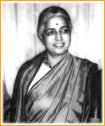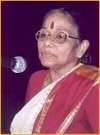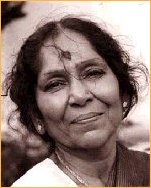
|
 |

|
 |
Sensual sringara to bhakti boredom: the brahminisation of Bharatanatyam by Lada Guruden Singh, New Delhi e-mail: ladasinghg@yahoo.com |
| August
2, 2003
"When Devadasis were edged out of their traditional arenas by girls from urban middle class families, the art of abhinaya suffered. Middle class mores demanded that exciting sringara be replaced by boring bhakti." - S Kalidas, former art critic with India Today  Rukmini Devi's statement, "The dance should not be sexy. Sexiness has no place in our arts," best sums up the concept of brahminisation of Bharatanatyam. Coming from an Indian looking back on erotic Indian literary works like Kama Sutra and Geeta Govinda, this is indicative of the austerity measures and convenient censorship of the dance form by Brahmins. Bharatanatyam traces its lineage to one strand of Dasiattam, which was performed during festivals by Devadasis at the temple mandapam (not at the sanctum) or at the court of the local raja. With the last Maratha ruler becoming only a figurehead under the British, the art form had to struggle for survival. After 1855, a long and painful transition began when the centre of gravity shifted from Thanjavur to Madras. The tumultuous changes that the Thanjavur court brought into the lives of the musicians and dancers resulted in a steady migration of the rootless artistes to small neighbouring states whose rulers kept the tradition alive by giving shelter to the displaced artistes. By the turn of the century, the growing metropolis of Madras began to lure them and they came in search of new patrons. Rich merchants, bankers and financiers who constituted the new aristocracy soon replaced the kings and feudal lords as patrons of culture. The merchant princes, the Chettiars and Mudaliars, provided sustenance to music and dance. Westernisation of education and lack of patronage for Indian arts, led to regional art forms losing significance. The new Hindu elite belonging to the administrative services and new professions of law, medicine and engineering, disdained Dasiattam to earn the respect of Englishmen. Though temple dancing was forbidden, the dance devotees practiced their art in the seclusion of their homes. E Krishna Iyer was a major force in the mid 1920s to fight for the Devadasi cause. He took to demonstrating on stage, the beauty of Sadir by donning female attire and giving lecture/demonstrations and solo performances.  Dance legend, M K Saroja's first memories of E Krishna Iyer's involvement with the revival and resurrection of Bharatanatyam go back to the mid-thirties when she first saw him as a child of six. "He lived in a small room, surrounded by books and pamphlets and he often walked miles in order to save bus fare. Although a lawyer by profession, he devoted full time to Bharatanatyam. He was full of energy, talking, walking, fighting cases... he would accompany our guru from kutcheri to kutcheri spreading the message of Bharatanatyam. He was like a man possessed. Without his efforts, our generation can safely say, the fortunes of Bharatanatyam would have been different." 1 His struggle and passion to see the continuation of the dance form gained momentum with the arrival on the scene of Rukmini Devi, wife of theosophist Englishman Dr. George Arundale. Rukmini Devi's own interactions and involvement with the work of Dr. Annie Besant and Theosophical Society of India helped her showcase Sadir (Bharatanatyam) to the high society of Madras as well as an international audience. Overwhelmed by the beauty of the performance she attended at E Krishna Iyer's invitation, the Brahmin beauty who had trained under Pavlova, took up the study of Bharatanatyam. The term Bharatanatyam itself was suggested by E Krishna Iyer and implemented by Rukmini Devi. Rukmini Devi was 31 when she made her debut in 1935 in a world of dance where even attending a Bharatanatyam performance was considered inappropriate. In the eyes of the public, a respectable lady from a respectable Brahmin family had given an electrifying performance. Irish poet Dr. James Cousins, who saw Rukmini Devi's debut, suggested the creation of an organisation where the dance form could be properly taught and popularised. Rukmini Devi herself found the need to start an institution, because she felt she had been "ushered into a new world of rhythmic beauty and meaning." So in 1936, she started the International Academy of the Arts in Adyar, which was later renamed Kalakshetra. She committed herself to finding young people who would dedicate themselves, "to the revival of this beautiful and profound art as an intrinsic factor in the cultural renaissance of India." Thus started a fresh chapter in Indian dance. To gain acceptance in society, some elements had to be modified - the dance form had to be distilled of its 'vulgar' emotions and unbecoming movements. Rukmini Devi focussed on ritual style and saw form as revealing content, the reason for this being her anticipation of secularisation of Indian dance form. Vatsalya and Bhakti replaced Sringara. The garish costumes and jewellery of the Devadasis were transformed into more tasteful creations. Bharatanatyam was sanitised and presented in a slick manner conforming to the social and cultural values of the Victorian new elite in Madras. This sanitised art was branded as 'brahminised' since Rukmini Devi was a Brahmin. According to guru V P Dhananjayan, "Nattuvanars in those days used to give a lot of problems. Rukmini Devi therefore started training non-nattuvanars like D Pashupati and Adyar Lakshman. Breaking the nattuvanar tradition was a milestone because Rukmini Devi wanted Bharatanatyam dancers to become self-dependent. Hence she was accused of making Bharatanatyam brahminical." Sadir's new avatar as Bharatanatyam also enabled the new proponents of the dance to claim for it the lineage of Bharata's Natyashastra, a book on dramaturgy compiled around 2nd century BC to 2nd century AD. According to some, it is called the 5th Veda. It seems this feeble link gave Vedic sanctity to Bharatanatyam, and legitimised the association of Brahmins with the dance. M K Saroja sums up, "E Krishna Iyer was a singular force in the revival of Bharatanatyam." 2 Kamala's role in popularising Bharatanatyam was crucial as well. Her immense popularity as a child artist on stage and in films made her a role model for the entire generation of children of elite classes in Madras. As Kamala went on to become a great dancer, girls from respectable families - especially Brahmin girls, Kamala being Brahmin herself - started to learn the dance from Devadasis. This being the case, the dance technique remained unchanged. While the Devadasis were condemned, displaced and later revived for academic debate, the Brahmins were accused of usurping the art, making it their own and dominating the art. So, in the course of just two generations, the 'despicable and offensive' dance of the Devadasi became the sanctified art of the Brahmin. According to late dance historian Mohan Khokar, " The climate of revivalism and resurrection and 'everything bad must be of foreign origin' was the mantra of this brahminical lot which set out to displace the Devadasi and usurp her art, devoid of the context. They wished to acquire and appropriate 'culture'. Bharatanatyam stood brahminised and an essentially Brahmin media and men in power, helped the process reach a pinnacle where the original practitioner of the art form, the Devadasi was shunned and the Brahmins all - the Rukminis, the Kalanidhis and the Kamalas - shone. Such is the strange history and fortunes of the form" Some say that Rukmini Devi saved the life of Dasiattam but killed its spirit. What did E Krishna Iyer himself think about Rukmini Devi? "There is no necessity to say that before she entered the field, the art was dead and gone or that it saw a renaissance only when she started to dance or that she created anything new, which was not before" (Dinamani 1948). 3 She essentially saved the dance and a systematic, institutionalised training improved the quality of dance and dancers. Conferences and debates furthered the cause of Bharatanatyam and in no time at all, Bharatanatyam established itself as the dominant classical dance form of India and achieved international fame. While dance benefited from the dedicated efforts of Brahmins - 'outsiders' - like E Krishna Iyer, Rukmini Devi and Kamala, one cannot overlook the contribution of the contemporary Devadasis - 'insiders' - the most prominent being Balasaraswati. The difference in outlook and approach of Rukmini Devi and Balasaraswati is evident from this exchange at a Kalakshetra demonstration in Delhi. When Balasaraswati remarked, "If you remove sringara from dance, what will people like us do?" Rukmini Devi answered, "I have no problem with sex or love, nor with portraying sringara, but the dance should not be sexy. Sexiness has no place in our arts." 4  Balasaraswati lashed out at this cleaned up brahminised dance, calling it in her turn 'vulgar'. Her disciple Nandini Ramani explains, "To remove the stigma attached to her community, Balasaraswati had to continue dancing incessantly to prove to the world and upper classes. There is so much talk about Rukmini Devi's contribution but no one talks about the essence of dance, which marked Bala and individualised her among her contemporaries. But Bala had a closed mind because of the circumstances and the societal codes at that time. Rukmini Devi secularised the art form because she was generous and broadminded. Unlike Bala, who due to the social treatment meted out to her community was very closed to the idea of teaching, Rukmini Devi's openness ensured that Bharatanatyam was taught to one and all." Bharatanatyam exponent Priyadarshini Govind (Chennai) agrees that art in India needed patronage and in a sense, Rukmini Devi provided that. Late Pattabhiraman, former editor of Sruti, Chennai, called Bharatanatyam a dance of India, not a Hindu dance, even though its performance corpus has historically been focussed on persona and narratives enveloped by Hindu faith. 5 But guru C V Chandrashekar says, "All the leading dancers in Bharatanatyam today are Brahmins. It was after all the effort of the community to save and serve dance due to which it became so popular. It was all about the survival of the fittest and the stronger community won." Dancer Navtej Johar thinks it will be a long time before the brahminisation of Bharatanatyam comes to an end, but Sadanand Menon (art critic, Chennai) feels, "The question is irrelevant in today's context". For Chandralekha, Bharatanatyam itself has become a diabolical art! Among the younger generation of artistes, Rama Vaidyanathan (Delhi) says, "The brahminical issue was only prevalent in the thirties." Guru Sudharani Raghupathy attributes the tag of brahminisation to the fact that Brahmins dominated the scene and this aspersion rose out of sheer jealousy. R Krishnaswamy, president of the Federation of Sabhas in Chennai goes to the extent of saying that brahminisation has never existed in Bharatanatyam, "It is an absolute misinformation. It's a farce." Not only brahminisation of the art, but brahminisation of characters also seems to be an issue, judging by the reactions to Anita Ratnam casting thapattam player Rangarajan in the role of Shiva in her production 'Gajaanana'. While many went backstage to congratulate her on taking the bold step of casting a dalit in the role of a god, a leading Tamil magazine was outraged. "The question of caste was nowhere on my mind, only the final outcome of my production," says Ratnam. It is a strange reaction from a dance critic because Bharatanatyam and other traditional temple dance forms are now being studied and practiced by people belonging to other faiths, like Navtej Johar, Dr. Francis Barboza, Father Saju George and Zakir Hussein to name a few. Mumbai based Mubina Bandukwala is the first Bohra Muslim girl to take to Bharatanatyam. As a dancer in the Diaspora, Ramaa Bharadvaj (California) voices her concern. "I am not sure that brahminical dominance exists anymore. Does it? Art belongs to those whose souls yearn for it. Being a Brahmin or not is not a personal choice. Your Brahmin father and Brahmin mother lusted for a few seconds in their Brahmin bed (or maybe in the backseat of their Brahmin car!) and you are conceived in a Brahmin household with a Brahmin name ... that's it. But that gives you no real right to brahminism. All brahminism will have to be earned by your quest in life. I was so disturbed during my last visit to India with the attitude of the Bhagavata Mela dance supporters who went around parading the fact that it is done even today ONLY by Brahmins. I was so immensely disturbed by it. These things have to go." The beauty of Bharatanatyam as we see it today is the contribution of the Devadasis, nattuvanars, Brahmins, non-Brahmins and non-Indians who have been practising this art. But as scholar Kapila Vatsyayan says, "It is in the nature of classical forms of Indian dancing that while they remain ancient and unchangeable on one level, they continue to grow or decline and certainly modify and assimilate new elements everyday." 6 Footnotes 1 - "The E. Krishna Iyer Medal for 2000 Awarded to Guru M K Saroja," Ashish Khokar, Natya Kala Conference 2000 2 - "Saroja's Sixty and Some Stray Strands," M K Saroja, Attendance 2000 3 - "The Legator and the Legatee of Bharatanatyam," B M Sundaram, Attendance 2000 4 - "Remembering Athai," Akila Ramnarayan, New Sunday Express, March 23, 2003 5 - Sruti, August 2001 6 - "Indian Classical Dance," Kapila Vatsyayan, 1992 References Vatsyayan, Kapila - Indian Classical Dance, Publications Divisions, I & B Ministry, Govt. of India, New Delhi, 1992 Khokar, Ashish (ed.)- attendance / The Dance Annual of India, Ekah Printways, New Delhi, 2001 Khokar, Ashish ( ed.)- attendance / The Dance Annual of India, Ekah Printways, New Delhi, 2000 Menon, Indira - The Madras Quartet/Women in Karnatik Music, Roli Books, New Delhi, 1999.  Lada Guruden Singh is a Delhi based Bharatanatyam dancer who recently completed his post- graduate diploma in journalism from the Asian College of Journalism, Chennai. The above article is an excerpt from his dissertation on "Bharatanatyam: In step with time" for which he interviewed gurus, dancers, editors, critics, presenters, art impresarios and dance historians in person, on telephone and email. |